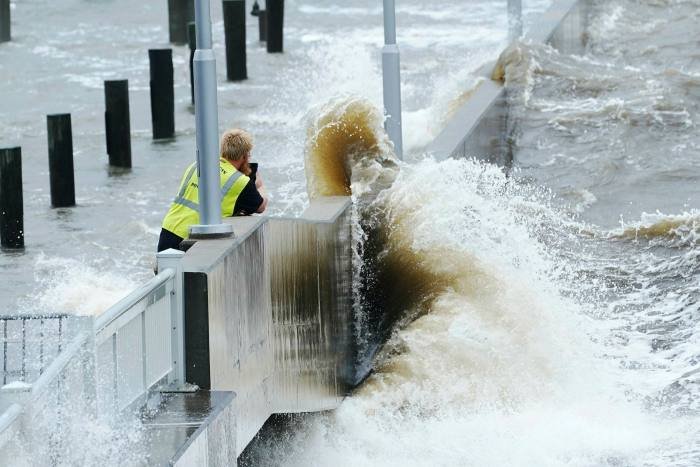Hurricanes updates
Sign up to myFT Daily Digest to be the first to know about Hurricanes news.
One of the biggest storms to pummel the US Gulf Coast in years wiped out power in New Orleans and killed at least one person, as Hurricane Ida brought widespread destruction to Louisiana and neighbouring states before being downgraded to a tropical storm.
Buildings blew apart in the high winds, homes were flooded in storm surges up to 3 metres deep, and tornadoes tore through areas on its flanks.
As wind speeds slowed on Monday morning after Ida made landfall it was downgraded but continued to dump heavy rain as the storm moved inland and through Mississippi.
Officials warned that levees could be inundated by the precipitation, which is forecast to be 25cm to 45cm on Monday across south-east Louisiana.
The emergency 9-1-1 hotline in New Orleans went down with “technical difficulties” in the early hours of Monday. Some residents who remained in the area despite evacuation orders reported being stranded on roofs and in attics.
More than 1m were without power across Louisiana, according to PowerOutage.US, which tracks disruptions to the country’s electrical network. New Orleans energy provider Entergy warned that those in the hardest-hit areas could be without power for weeks.
“It will likely take days to determine the extent of damage to our power grid and far longer to restore electrical transmission to the region,” the energy group said on Monday morning.
Hurricane Ida reached wind speeds of 165km per hour but authorities said a $15bn system of pumps, levees and flood barriers built after Hurricane Katrina had prepared the region for such events © Bloomberg
The National Hurricane Center said the Category 4 storm made landfall near Port Fourchon, Louisiana, about 100km south of New Orleans. Its 230km per hour (150mph) winds compared with peak speeds of up to 280km during Hurricane Katrina in 2005.
Ida was later downgraded to a Category 3 storm as it approached New Orleans, and by morning on Monday had weakened further. The NHC’s latest advice included warnings of dangerous storm surges, damaging winds, and flash flooding.
“This is one of the strongest storms to make landfall here in modern times,” John Bel Edwards, Louisiana governor, said at a press conference. “We can expect devastating impacts to continue for the next 24 hours or so.”

A utility worker photographs waves at a sea wall in Bay Saint Louis, Mississippi, as the hurricane approaches © AP
Edwards said it would be difficult to estimate the extent of the damage until the storm cleared and authorities were able to survey the region.
The storm gathered strength overnight, fuelled by a pocket of unusually warm and deep water in the Gulf of Mexico, which some scientists have attributed to the effects of climate change.
Ida arrived in New Orleans 16 years to the day after Hurricane Katrina, which overwhelmed the low-lying region’s flood defences and killed more than 1,800 people.
Despite fears of widespread damage, officials said a $15bn system of pumps, levees and flood barriers built after Katrina had prepared the region for storms such as Ida.
That system was “expected to hold and perform as intended”, Edwards said. “Will it be tested?” he said. “Yes. But it was built for this moment.”
National Oceanic and Atmospheric Administration satellite image showing Ida moving inland from Louisiana © NOAA/GOES/AFP via Getty Images
At the same time in the Atlantic on Sunday, Tropical Storm Julian became the 10th named storm of the 2021 hurricane season before being downgraded to a tropical cyclone in the early hours of Monday.
Many Gulf Coast residents had evacuated in recent days, clogging airports and roads. Those who remained received warnings from officials as the storm approached.
US president Joe Biden approved emergency declarations for Louisiana and Mississippi and federal agencies were deployed to set up shelters and support recovery efforts.
A surging Covid-19 outbreak threatened to complicate the storm response, as hospitals were already stretched to capacity with pandemic-related hospitalisations and deaths at record levels.
Recommended

The storm also sent ripples through energy markets as it barrelled through the heart of the Gulf of Mexico’s oil-producing region, threatening “extensive damage” to refineries, petrochemical facilities and liquefied natural gas export plants, according to S&P Global Platts Analytics.
Oil producers, including Shell and BP, evacuated offshore platforms in the Gulf, shutting off 1.74m barrels a day of crude output, 96 per cent of the area’s production and more than 15 per cent of total US output, according to federal government data.
US petrol futures were up 2.6 per cent in Asian trading on Monday following the disruption.
Additional reporting by Hudson Lockett in Hong Kong and Leslie Hook in London
Climate Capital

Where climate change meets business, markets and politics. Explore the FT’s coverage here.
Are you curious about the FT’s environmental sustainability commitments? Find out more about our science-based targets here


